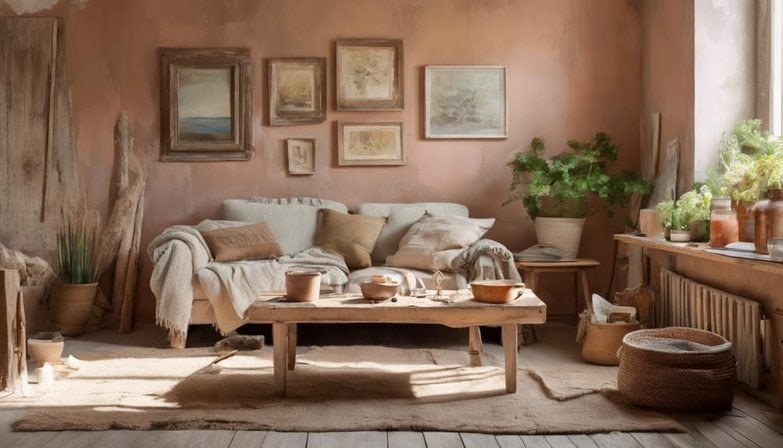Is Milk Paint Googd for Interior Walls? Uses and Benefits


Milk paint is great for interior walls because it’s eco-friendly, non-toxic, and made from natural ingredients. You’ll find it’s perfect for achieving a vintage or shabby chic aesthetic. This paint is safe for children and pets, and its breathable nature helps prevent mold and mildew. Milk paint dries quickly within 30 minutes to an hour, though curing can take up to 30 days. It works best on porous surfaces, enhancing texture without needing primers. Its historical significance and versatility make it ideal for different interior styles. If you’re looking for a unique finish with health benefits, this paint is ideal.
Key Takeaways
- Milk paint provides a natural, eco-friendly finish for interior walls.
- It is non-toxic, making it safe for children and pets.
- Offers a vintage or shabby chic aesthetic perfect for rustic interiors.
- Dries quickly, typically within 30 minutes to an hour.
- Made from biodegradable ingredients, reducing environmental impact.
What are Milk Paints best for?
Milk paints are best for achieving a natural, eco-friendly finish on interior walls. If you’re looking to breathe new life into your home, milk paint offers a versatile solution. One of its standout uses is for furniture refinishing. This type of paint adheres beautifully to wood, giving your old furniture a fresh, rustic look that’s hard to achieve with other paints. It’s perfect for that vintage or shabby chic aesthetic you might be aiming for.
When it comes to kitchen cabinets, milk paint is also an excellent choice. Its durability and ability to withstand daily wear and tear make it ideal for high-traffic areas like the kitchen. You can easily apply it to your cabinets to give them a smooth, matte finish that’s both visually pleasing and functional.
Milk paint isn’t just limited to indoor uses; it’s also great for outdoor projects. Whether you’re working on a garden bench or wooden patio furniture, milk paint’s natural ingredients make it a safe option for the environment. Plus, it penetrates the wood, offering a long-lasting finish that stands up to the elements.
Are there Milk Paints Benefits?
One of the major benefits of using milk paint is its eco-friendly composition, which makes it a safe and sustainable choice for your home. Milk paint is made from natural ingredients, including milk protein (casein), lime, and earth pigments. This non-toxic formula means you won’t have to worry about harmful chemicals or fumes, making it an excellent option for interior walls.
Here are some key benefits of using milk paint:
- Environmental benefits: Milk paint is biodegradable and doesn’t contribute to pollution. It’s a green choice that aligns with eco-conscious living.
- Natural ingredients: Made from simple, natural components, milk paint is free from synthetic additives and preservatives.
- Non-toxic formula: Safe for use around children and pets, milk paint contains no volatile organic compounds (VOCs) or other harmful substances.
- Versatility: You can use milk paint on a range of surfaces, including wood, drywall, and plaster, giving you flexibility in your home projects.
- Breathability: Unlike some other paints, milk paint allows surfaces to breathe, preventing issues like mold and mildew and promoting a healthier indoor environment.
When to use Milk Paints?
Consider using milk paints when you want an eco-friendly, non-toxic option for your interior walls that also provides a unique, vintage aesthetic. Milk paints have historical significance, dating back to ancient times, and were commonly used in colonial America. Their natural ingredients make them a sustainable choice, perfect for those looking to minimize their environmental impact.
Milk paint is ideal for achieving a vintage or weathered look, making it a popular choice for restoration projects or vintage-themed interiors. The application techniques vary, allowing you to create different textures and finishes. You can apply it with a brush, roller, or sprayer, depending on the desired effect. For a more rustic appearance, consider using a brush to leave visible strokes and slight imperfections.
The color variety available with milk paints is impressive, ranging from soft pastels to deep, rich hues. These colors can be easily mixed to create custom shades, giving you the flexibility to match your interior design exactly. Whether you’re aiming for a farmhouse look or a more traditional style, milk paint offers versatility and charm, making it a valuable asset to your interior design toolkit.
Drying and Curing Times
When using milk paint, you’ll find that it typically dries within 30 minutes to an hour, but curing can take up to 30 days. The drying conditions, such as temperature and airflow, play a vital role in how quickly the paint dries. However, the curing process is what ultimately determines the paint’s durability and finish.
Humidity impacts both drying and curing times. In high humidity, milk paint may take longer to dry and cure, while in low humidity, the process speeds up. To guarantee the best results, it’s important to control your environment as much as possible.
Consider these factors for optimal drying and curing:
- Temperature: Aim for a moderate temperature, around 70°F (21°C), for best results.
- Airflow: Good ventilation helps the paint dry faster and more evenly.
- Humidity: Keep humidity levels between 40-60% for ideal curing.
- Layer Thickness: Thicker layers take longer to dry and cure; apply thin, even coats.
- Surface Preparation: Properly prepared surfaces help the paint adhere better and dry more uniformly.
Is Milk Paint good for Living room and Bedroom?
After understanding the drying and curing times, you might wonder if milk paint is a good choice for your living room and bedroom. Milk paint offers a range of color options, from soft pastels to rich, earthy tones, making it versatile for different styles. The matte finish provides a cozy, vintage feel that can improve the ambiance of both spaces.
Before you start painting, surface preparation is important. Make sure the walls are clean, dry, and free from peeling paint or other imperfections. Sanding smooths out rough areas, allowing the milk paint to adhere better. If you’re painting over a non-porous surface, consider using a bonding agent to enhance adhesion.
Application techniques can vary, but using a quality brush or roller ensures even coverage. Milk paint can be applied in thin layers, and multiple coats might be needed for the desired opacity. It’s also easy to create unique, textured finishes by using different brush strokes or blending colors.
Is Milk Paints Safe for Health?
Milk paint is often praised for its health benefits, as it contains natural ingredients free from harmful chemicals. This makes it an excellent choice for anyone concerned about indoor air quality and personal health.
Unlike conventional paints, milk paint doesn’t emit volatile organic compounds (VOCs), which are harmful chemicals that can cause headaches, dizziness, and long-term health issues.
Here are some key reasons why milk paint is considered safe for health:
- Low VOCs Emission: Milk paint is made from natural ingredients, resulting in minimal VOCs emission.
- Allergy Risks: It reduces allergy risks since it lacks synthetic additives that can trigger reactions.
- Eco-Friendly Ingredients: Milk paint consists of biodegradable, eco-friendly ingredients, making it a sustainable option.
- Non-Toxic: The natural components in milk paint make it non-toxic, even during application.
- Odorless: Unlike many other paints, milk paint typically has little to no smell, making it more pleasant to use.
How to tell if Paint is Milk?
You might be wondering how to identify if the paint you’re considering is actually milk paint. To begin with, check the ingredients. Milk paint typically contains milk protein (casein), lime, and natural pigments. It’s free from synthetic chemicals, making it eco-friendly.
To further discern milk paint, consider its historical significance. Milk paint has been used for centuries, so if you’re working with an older home or historical renovation, there’s a good chance it’s milk paint. Additionally, examine the color variations. Milk paint often leaves a matte finish and can have subtle color variations due to its natural ingredients.
When evaluating application techniques, note that milk paint is usually mixed from a powder form and applied in thin, multiple coats. It doesn’t require an addition and adheres well to porous surfaces.
Here’s a quick table to help you identify milk paint:
| Characteristic | Details |
|---|---|
| Ingredients | Milk protein, lime, natural pigments |
| Historical Use | Centuries-old, used in historical renovations |
| Color Variations | Matte finish, subtle natural variations |
| Application Method | Mixed from powder, thin multiple coats |
| Surface Compatibility | Best on porous surfaces, no addition needed |
Frequently Asked Questions
How Does Milk Paint Compare to Latex Paint in Terms of Durability?
You’ll find that milk paint has lower VOC emissions and a shorter drying time than latex paint. However, latex paint often offers greater durability. Milk paint’s finish texture provides a unique, rustic look compared to latex.
Can Milk Paint Be Used on Surfaces Other Than Walls?
Yes, you can use milk paint on surfaces other than walls. It’s great for furniture painting and wooden surfaces, and you can even apply it for outdoor applications if you seal it properly.
Does Milk Paint Require a Special Primer Before Application?
You don’t always need a special primer for milk paint, but primer selection can help with adhesion issues. Proper surface preparation is key; sanding and cleaning beforehand can guarantee better adhesion and a smoother finish.
Are There Any Specific Techniques for Applying Milk Paint?
For applying milk paint, surface preparation is essential. Clean and sand the area initially. Use appropriate application tools like brushes or sprayers. Allow adequate drying time between coats to achieve the best finish.
Can Milk Paint Be Mixed to Create Custom Colors?
You can definitely mix milk paint to create custom colors. By using different color blending and mixing techniques, you’ll achieve unique custom shades perfect for your project. Experiment and find the perfect hue for your space.
